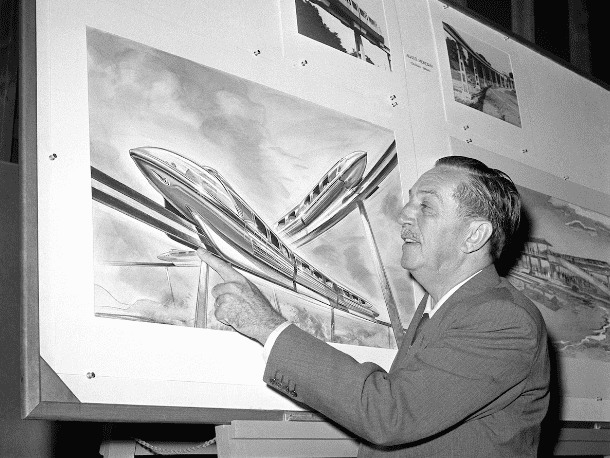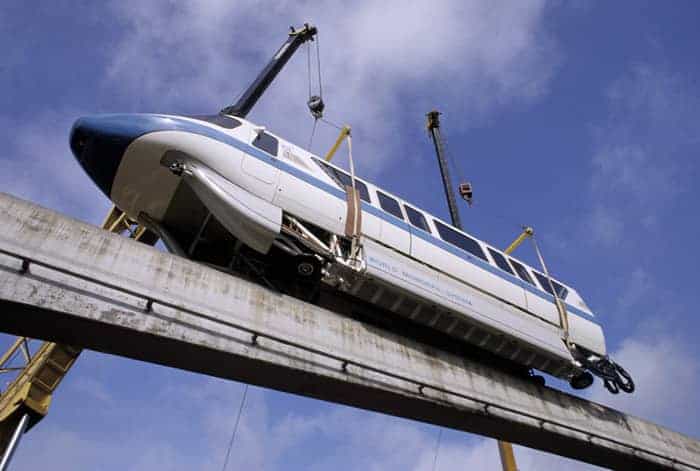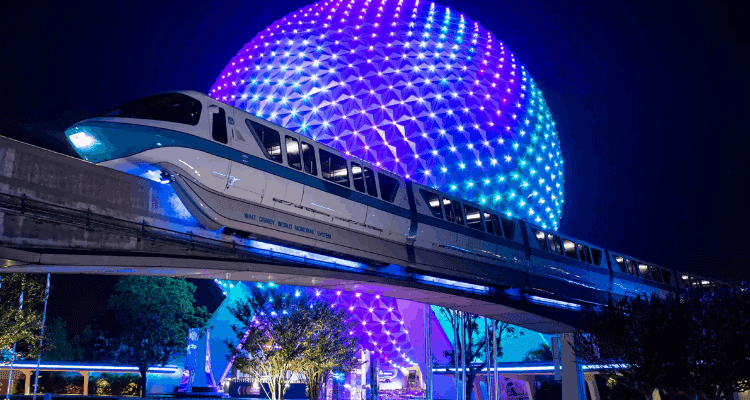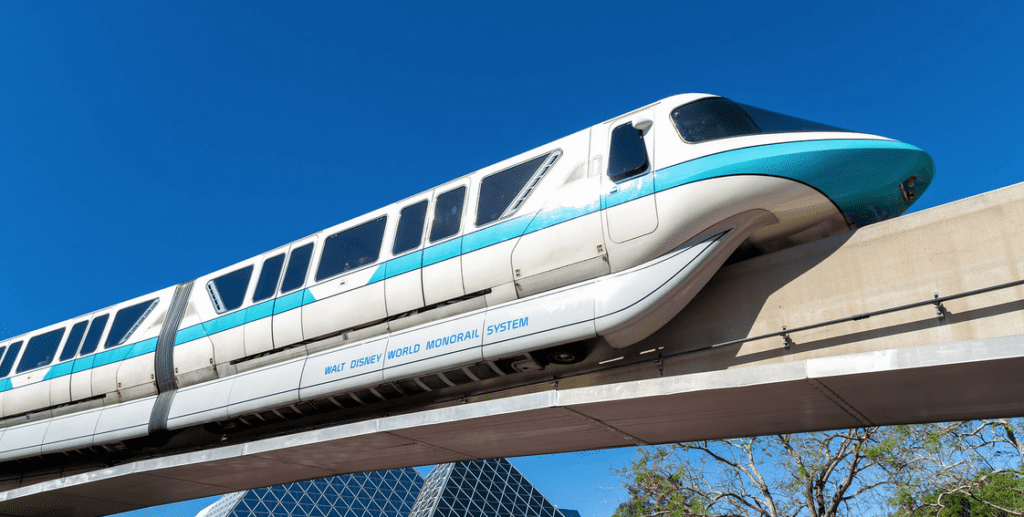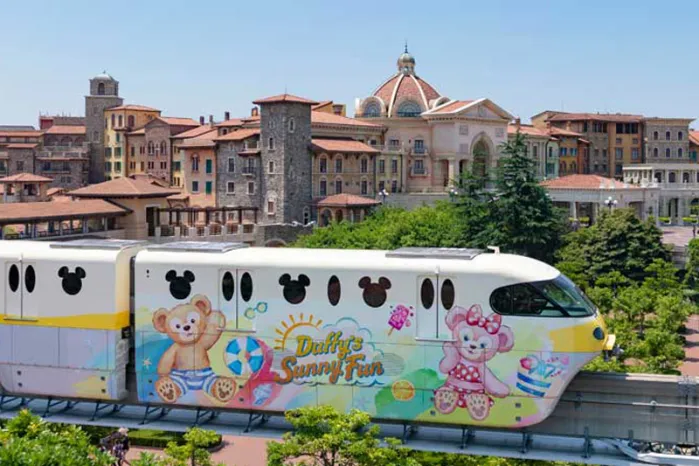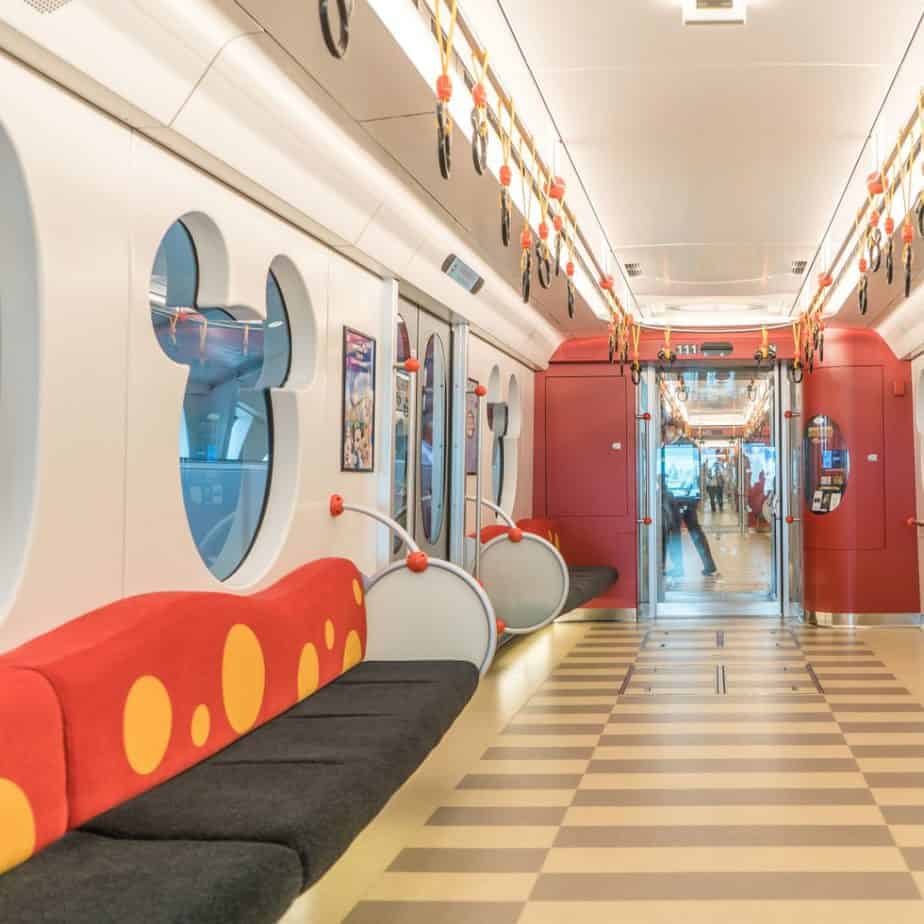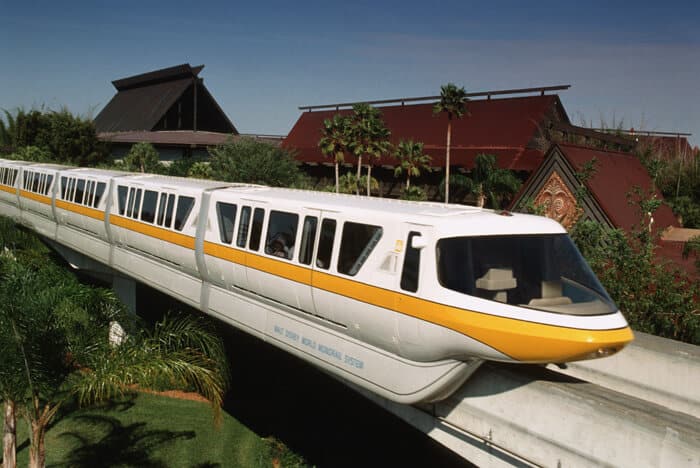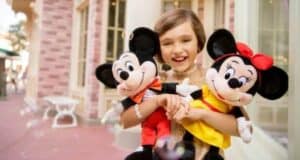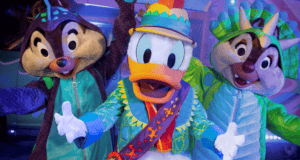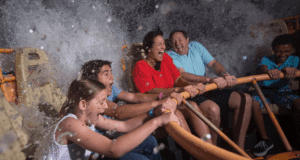
Disney Monorail Transportation is a longtime staple found at three of the six Disney Parks around the world. Serving the dual purpose as both a convenient mode of transportation as well as an attraction, many Guests feel fairly familiar with its distinguishable setup as a sleek, smooth-running railway on elevated beams. But there is just so much more to know about the Disney Monorail and its extensive history. From the original concept that came about from Walt Disney himself to the innovative features these rail cars all boast, here are some compelling facts we think you may find fascinating about the Disney Monorail System.
Related: Fun Facts About Walt Disney World’s Monorail System
Walt’s Initial Idea
It was back in the 1950s when Walt Disney became privy to a new mode of suspended railway travel that was being tested out in Germany. Intrigued and captivated, he saw great potential for such a mode of travel to go on and one day become the transportation of the future. He was so inspired by it all that he ended up creating his very own incarnation of such—the Disney Monorail.
Appropriately enough, when Disneyland Park opened back in 1959, it featured a fully functioning monorail onsite. Serving its primary purpose as an innovative new mode of travel, many Guests also found great delight in riding the rails for pure entertainment. Disney’s monorail was the first one of its kind to emerge on the scene in the United States.
Related: 15 Impressive Facts About Disney’s Monorail System
Building Monorails at Disney Parks
Disney’s very first-ever monorail was known as the Mark I. Designed by Bob Gurr, this was the model that premiered at Disneyland on opening day. Unlike the six-vehicle setups of today, the Mark I only contained three interconnected cars. Eventually, updated Mark models came out, with numerous improvements and developments being made along the way.
The company that was called on to build the original Mark I as well as the next edition of the Mark II was ALWEG. Walt Disney Imagineering, originally WED Enterprises, built both the Mark III and Mark V models. Martin Marietta was the company behind the Mark IV. Bombardier created the Mark VI, which is still in operation at Walt Disney World today. Disneyland’s current Mark VII was done by Dynamic Structures.
What Thin Tracks They Have!
Have you ever looked closely at those thin beam-like tracks by which Disney Monorails zoom by on so steadily? It’s amazing to think that such a narrow line, no thicker than 26 inches wide, could actually support such large train cars brimming with passengers.
Track beams for Disney Monorails are supported by tapered columns, done up in sets of six, post-tensioned, and spaced about 110 feet apart from one another. This forms a combined single structure of 600 feet. What’s even more shocking is what the center of monorail beams contain. It’s none other than polystyrene, better known as Styrofoam, encased in both steel and concrete.
Related: Skip the Crowds! Don’t Miss This Monorail Trick at Disney World
Which Disney Destinations Have Them?
Even though Walt Disney’s original concept for monorails to make it big as a new form of mass transit didn’t take off according to plan, they did go on to become integral at three existing Disney Resorts around the world. The Disney destinations that sport their very own monorail systems include Disneyland in California (of course), Walt Disney World Resort in Florida, and Tokyo Disney Resort in Japan.
Each Monorail System shares all the obvious similarities across the board. Yet they are all vastly different entities from one another and sport additional unique callouts.
Related: The Major Differences Between Walt Disney World & Disneyland Resorts
Disneyland’s Monorail
The first and most senior of all Disney Monorails in operation today, this is the only line that actually features a stop within the limits of an actual Disney theme park. Its station can be found within Tomorrowland. Making up the line of the Disneyland Monorail you have a three-train fleet distinguishable as the Red, the Blue, and the Orange.
Walt Disney World’s Monorail
The Walt Disney World Monorail is by far the most extensive of all Disney Monorails. While the others feature only a single track route, the Walt Disney World version actually includes three lines. There is one that runs between the Magic Kingdom Park and the three area Resorts—Disney’s Grand Floridian, Disney’s Polynesian Village, and Disney’s Contemporary. There is another Express Monorail that connects to the Transportation and Ticket Center. A third is the EPCOT line, which runs back and forth between the Park and TTC. In all, Disney World boasts a fleet of 12 train cars. They are distinguishable by the following colors: Coral, Gold, Orange, Red, Yellow, Blue, Green, Lime, Teal, Silver, Black, and Peach.
Tokyo Disney Resort Monorail
Quite different from its American counterparts, the Tokyo Disney Resort Monorail is perhaps the most traditional of all monorail systems. It also happens to be the only one that does not offer rides as part of a Resort complimentary service, with a current rate for riding standing at 260 yen.
The railway system is operated by Maihama Resort Line Co, Ltd., a subsidiary of the Oriental Land, Co., which also operates the Tokyo Disney Resort. Therefore, the monorail line stops can be picked up at both Maihama Station and Tokyo Disney Resort, with a route that follows on a counter-clockwise course between the two.
Another interesting callout is the design these train cars follow, which is longer than those at both Disneyland and Disney World. As a result, they are able to carry 571 people at a time as opposed to the 364 the others boast. The Tokyo monorails also have far more Disney-like designs with Mickey Mouse-shaped windows and other elemental theming on all five of the trains consisting of their fleet. But perhaps the most unique feature of all is that these monorails are automated and driverless, with Cast Members present at the rear of all trains to assist boarding passengers in any needs.
Related: You Will Now Need a Visa to Visit This Disney Park
Daily Maintenance
Disney takes safety seriously. So, it should come as no surprise to learn that testing and maintenance is performed on the monorails each and every day, in order to keep them in optimal working order.
In addition to running checks on all the usual, Disney consistently tests out its MAPO system—a block light system that detects motion and distance between the different trains. The name “MAPO” was given by Walt Disney in honor of the movie Mary Poppins from 1964.
Related: Several Disney Resorts Schedule Lengthy Maintenance Downtime
Emergency Escape Routes
Even with daily safety runs and tests to keep monorails performing in top-notch order, being prepared for an actual onboard emergency is of equal importance. Fortunately, though monorail emergencies have been very uncommon in the past. All the same, Disney has an effective escape plan in place just the same with three viable routes to exit by, in the event that passengers ever need to be evacuated immediately. To start, each and every train car has its very own internally opening window. This enables passengers to crawl out if ever the need arises. There is also a trapdoor on the car ceiling—a rooftop escape. Additionally, you will notice a door located in the monorail exterior, to be opened in the event of an emergency by releasing air pressure. If evacuation is ever necessary, Disney instructs Guests to head directly for the rooftop of the monorail train car where they would be assisted further by first responders and safety authorities. Additionally, passengers may be guided across the top to the front car where the pilot would then attach a rope for the use of crawling down to the lower beam.
Related: Secret Exit to Pirates of the Caribbean Revealed
Eco-Friendly
While we are increasingly more mindful of eco-friendly solutions these days, Disney has been ahead of the game all along. Because the Disney Monorail System runs entirely on electricity, absolutely zero gas goes into such operations. The motors rely on a 600-volt electrical system, which runs through a bus bar found on either side of the monorail beam. It’s just something else to feel good about when riding the rails of the Disney Monorail System.
Related: The Many Conservation Efforts at Work on Walt Disney World Property
Like many of Disney’s most iconic Park staples, there is such an extensive story behind Disney Monorail Transportation that you probably never even realized. Now that you know a little more, doesn’t it just make you want to hop aboard and go for a ride right now?

